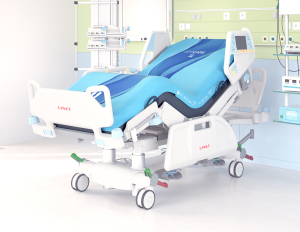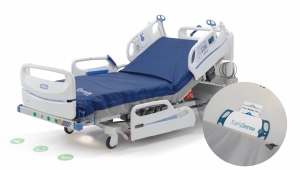The humble hospital bed joins the ranks of smart medical devices
March 11, 2019
by John W. Mitchell, Senior Correspondent
Before there were CT and MR scanners, before electronic medical records and robotic surgery – even before the stethoscope – there was the hospital bed. The gurney, stretcher, litter or whatever it might be called is the equipment that most hospital patients first encounter. Take it away, and hospital operations would come to a standstill. Fortunately, the once lowly hospital bed is emerging as a medical device taking an active role within a modern, interconnected medical facility.
“Beds are becoming highly configurable. Manufacturers are offering a high degree of customization with a multitude of options to choose from,” Ismael Cordero, senior project engineer at ECRI Institute told HCB News. “Bed designs are changing to improve patient experience: Verbal alerts to patients, USB charging ports, storage areas for patient devices, nightlights, and patient control of mattress firmness.”
He said that ECRI had seen a steady rise in interest for "smart beds" for both medical-surgical and critical care applications. For example, verbal commands such as "care team have been called" or "brake not set" can help both patients and caregivers better understand the safety environment. Safety status icons projected onto the floor can quickly alert caregivers of fall-risk conditions, such as when the bed is not in its lowest position or when the bed exit alert is not on.
Healthcare facility interest in patient beds built with smart capabilities have been on the ascendency in recent years, and is observable across all types of inpatient healthcare facilities, according to Neff Conner, analyst at MD Buyline. Beds designed to care for obese, or bariatric, patients to avoid staff injuries are also a prominent trend he cited.
"Patient safety, patient comfort, and caregiver safety are of primary importance to the hospitals, so these factors are driving this trend that we have been monitoring over the past decade," Conner told HCB News. "We expect to see greater interest in smart beds as older beds age out of their useful lifespan. This increase will most likely remain steady since the useful life expectancy for patient beds is ten years and up."
Paul Johnson, president, patient support systems at Hill-Rom, said that the big themes in beds are safety, patient satisfaction, and connectivity. As such, beds have evolved as advanced medical devices that need to do more than the beds of the past. For example, prevention and even healing of pressure injuries is vital, as is ensuring technology that enables early mobility. Hill-Rom is introducing incontinence detection to solve a key customer and patient need for reducing incontinence-associated dermatitis and improving patient dignity.
The company has also integrated advanced features beyond the bed alarm. These include visual cues projected on the floor to allow caregivers to know the status of a patient merely walking by the patient's room. Such features allow patients to get more rest, he said, and caregivers to spend time with patients who need attention. In the patient satisfaction realm, Hill-Rom provides built-in USB ports and mobile device storage pockets on the inside of the railing. This prevents patients from reaching far outside the bed – and potentially falling or straining when they shouldn’t – just to reach their mobile phones.
“We and our competitors are constantly raising the bar in terms of the intelligence, capabilities, and connectivity we build into hospital beds themselves,” Johnson said. “The high level of care now available in the ICU and the medical-surgical units, specifically related to where the patient spends the most time, represents the biggest and most rapid advance in hospital beds in the last ten years.”
On the interconnectivity front, think “big picture”. Hill-Rom alone, Johnson said, has more than 750,000 medical devices in the market today with connectivity capability. Combined with the new LINQ mobile wireless platform, it provides a platform to integrate staff and patient interactions with clinical systems. Such insight helps improve care team collaboration, communication, compliance, and efficiency.
“This is a great time to be in the medical device world,” Johnson said. “The rapid advancement in hospital beds and other connected technologies makes the job of caring for even the sickest patients safer and less complex, and new data connectivity solutions will give caregivers greater, faster insight. Beds are a key part of the puzzle.”
Andrew Aitken, director of product management and marketing at LINET Americas also speaks of a similar high-level view of the hospital bed. As hospitals seek to improve outcomes, avoid "never-events" such as fatal falls, and reduce caregiver injuries, he said that the bed frame begins to take center stage.
“The bed is the single piece of equipment that every patient is in intimate contact with every day of their stay and directly impacts the care being provided,” he told HCB News. “With all of this in mind manufacturers are including technology to address issues such as comfort, ease of use and delivery of care.”
Such features include lighted bed controls and standard USB chargers demanded by patients. The bed also occupies a unique position in the delivery of care, such as turn assist – a feature that traditionally resided in the mattress. However, Aitken said, LINET has incorporated this into the frame, which increases efficiency and use by the staff. This simple feature helps to not only reduce the pain experienced by patients in daily care activities such as linen changes, skin inspection, and patient hygiene, but it also reduces caregiver strain and injury by utilizing gravity to help reposition or turn a patient.
Reducing clinician injury is no small matter. According to the Department of Labor, every year nursing employees incur more than 35,000 primarily back injuries severe enough that they lose time from work. That’s three times the injury rate of construction laborers.
“Hospitals and all healthcare have begun to ask more of both the equipment… Slowly, manufacturers are responding to the need to care not only for patients but also for the caregivers," said Aitken.
Beds will become even more of an active player on the interconnected hospital front as nursing and IT become even more integrated, driving data to the EMR. Only a few health systems have achieved this standard, according to Aitken, but it holds great promise. Improved Interaction between the nursing/medical staff and the IT staff has begun to give rise to analyzing the data collected or utilizing the sensor data in novel ways.
"A great example: a facility I worked with last year was doing the workflow programming for their EMR. Staff pointed out the need to document Q2 hour turns required for several quality initiatives," recalled Aitken. "The nurses worked with the IT staff to develop a workflow and reminder utilizing the turn sensor data from the LINET beds to document not only if the turn was done, but the direction and degree of the turn.”
He added that the next step is to bring artificial intelligence into the equation so the bed can make suggestions to improve patient care, nurse safety and efficiency in real time. This capability will enable a bed to make customized recommendations for the care of each individual patient.
While most of the manufacturers reported steady recent sales, NOA Medical Industries has seen an upward trend in the past three years, according to Steven Sauerwein, vice president of sales and marketing. He said that according to one industry analysis, the bed market is expected to grow at a 5.5 percent compounded growth rate through 2024.
“Life cycle of beds tends to vary from facility to facility, many times due to economic or budgetary requirements,” said Sauerwein. “Many hospitals are looking to upgrade to newer technologies, but look for best price, best features, best functions – a total package. Many companies offer ... many bells and whistles in hopes of offering a competitive edge but … do not meet the needs of critical access or rural hospital bed markets from a price perspective.”
The built-in nurse call, bed exit alarm, and scales tend to be an excellent way to manage costs by incorporating what used to be multiple products or technologies into one product, offering ease of use and convenience. The challenge, said Sauerwein, is for these technologies to be presented as value-added features to the facilities in a cost-effective manner. NOA, he said, achieves this through their built-in, patent-pending scale, saving the facility money by not requiring any calibration. Also, their exit alarm ties to the nurse call system, assisting in patient monitoring. Moreover, a new feature coming out in 2019 will include the integrated touch screen, monitoring, and reporting functions, as well as push-button electronic central and directional locking for the bed.
Johnson, with Hill-Rom also acknowledged the importance of being sensitive to cost. Hospitals are looking to do business with fewer, bigger players as a way of getting the best technology at a manageable cost.
“They are looking not only at the cost of capital but also at the potential to avoid future costs due to patient complications down the road from not having the right technology,” he said. “From our vantage point, the hospital bed becomes an even more powerful caregiving tool for hospitals.”
“Beds are becoming highly configurable. Manufacturers are offering a high degree of customization with a multitude of options to choose from,” Ismael Cordero, senior project engineer at ECRI Institute told HCB News. “Bed designs are changing to improve patient experience: Verbal alerts to patients, USB charging ports, storage areas for patient devices, nightlights, and patient control of mattress firmness.”
He said that ECRI had seen a steady rise in interest for "smart beds" for both medical-surgical and critical care applications. For example, verbal commands such as "care team have been called" or "brake not set" can help both patients and caregivers better understand the safety environment. Safety status icons projected onto the floor can quickly alert caregivers of fall-risk conditions, such as when the bed is not in its lowest position or when the bed exit alert is not on.
Healthcare facility interest in patient beds built with smart capabilities have been on the ascendency in recent years, and is observable across all types of inpatient healthcare facilities, according to Neff Conner, analyst at MD Buyline. Beds designed to care for obese, or bariatric, patients to avoid staff injuries are also a prominent trend he cited.
"Patient safety, patient comfort, and caregiver safety are of primary importance to the hospitals, so these factors are driving this trend that we have been monitoring over the past decade," Conner told HCB News. "We expect to see greater interest in smart beds as older beds age out of their useful lifespan. This increase will most likely remain steady since the useful life expectancy for patient beds is ten years and up."
Paul Johnson, president, patient support systems at Hill-Rom, said that the big themes in beds are safety, patient satisfaction, and connectivity. As such, beds have evolved as advanced medical devices that need to do more than the beds of the past. For example, prevention and even healing of pressure injuries is vital, as is ensuring technology that enables early mobility. Hill-Rom is introducing incontinence detection to solve a key customer and patient need for reducing incontinence-associated dermatitis and improving patient dignity.
The company has also integrated advanced features beyond the bed alarm. These include visual cues projected on the floor to allow caregivers to know the status of a patient merely walking by the patient's room. Such features allow patients to get more rest, he said, and caregivers to spend time with patients who need attention. In the patient satisfaction realm, Hill-Rom provides built-in USB ports and mobile device storage pockets on the inside of the railing. This prevents patients from reaching far outside the bed – and potentially falling or straining when they shouldn’t – just to reach their mobile phones.
“We and our competitors are constantly raising the bar in terms of the intelligence, capabilities, and connectivity we build into hospital beds themselves,” Johnson said. “The high level of care now available in the ICU and the medical-surgical units, specifically related to where the patient spends the most time, represents the biggest and most rapid advance in hospital beds in the last ten years.”
On the interconnectivity front, think “big picture”. Hill-Rom alone, Johnson said, has more than 750,000 medical devices in the market today with connectivity capability. Combined with the new LINQ mobile wireless platform, it provides a platform to integrate staff and patient interactions with clinical systems. Such insight helps improve care team collaboration, communication, compliance, and efficiency.
“This is a great time to be in the medical device world,” Johnson said. “The rapid advancement in hospital beds and other connected technologies makes the job of caring for even the sickest patients safer and less complex, and new data connectivity solutions will give caregivers greater, faster insight. Beds are a key part of the puzzle.”
Andrew Aitken, director of product management and marketing at LINET Americas also speaks of a similar high-level view of the hospital bed. As hospitals seek to improve outcomes, avoid "never-events" such as fatal falls, and reduce caregiver injuries, he said that the bed frame begins to take center stage.
“The bed is the single piece of equipment that every patient is in intimate contact with every day of their stay and directly impacts the care being provided,” he told HCB News. “With all of this in mind manufacturers are including technology to address issues such as comfort, ease of use and delivery of care.”
Such features include lighted bed controls and standard USB chargers demanded by patients. The bed also occupies a unique position in the delivery of care, such as turn assist – a feature that traditionally resided in the mattress. However, Aitken said, LINET has incorporated this into the frame, which increases efficiency and use by the staff. This simple feature helps to not only reduce the pain experienced by patients in daily care activities such as linen changes, skin inspection, and patient hygiene, but it also reduces caregiver strain and injury by utilizing gravity to help reposition or turn a patient.
Reducing clinician injury is no small matter. According to the Department of Labor, every year nursing employees incur more than 35,000 primarily back injuries severe enough that they lose time from work. That’s three times the injury rate of construction laborers.
“Hospitals and all healthcare have begun to ask more of both the equipment… Slowly, manufacturers are responding to the need to care not only for patients but also for the caregivers," said Aitken.
Beds will become even more of an active player on the interconnected hospital front as nursing and IT become even more integrated, driving data to the EMR. Only a few health systems have achieved this standard, according to Aitken, but it holds great promise. Improved Interaction between the nursing/medical staff and the IT staff has begun to give rise to analyzing the data collected or utilizing the sensor data in novel ways.
"A great example: a facility I worked with last year was doing the workflow programming for their EMR. Staff pointed out the need to document Q2 hour turns required for several quality initiatives," recalled Aitken. "The nurses worked with the IT staff to develop a workflow and reminder utilizing the turn sensor data from the LINET beds to document not only if the turn was done, but the direction and degree of the turn.”
He added that the next step is to bring artificial intelligence into the equation so the bed can make suggestions to improve patient care, nurse safety and efficiency in real time. This capability will enable a bed to make customized recommendations for the care of each individual patient.
While most of the manufacturers reported steady recent sales, NOA Medical Industries has seen an upward trend in the past three years, according to Steven Sauerwein, vice president of sales and marketing. He said that according to one industry analysis, the bed market is expected to grow at a 5.5 percent compounded growth rate through 2024.
“Life cycle of beds tends to vary from facility to facility, many times due to economic or budgetary requirements,” said Sauerwein. “Many hospitals are looking to upgrade to newer technologies, but look for best price, best features, best functions – a total package. Many companies offer ... many bells and whistles in hopes of offering a competitive edge but … do not meet the needs of critical access or rural hospital bed markets from a price perspective.”
The built-in nurse call, bed exit alarm, and scales tend to be an excellent way to manage costs by incorporating what used to be multiple products or technologies into one product, offering ease of use and convenience. The challenge, said Sauerwein, is for these technologies to be presented as value-added features to the facilities in a cost-effective manner. NOA, he said, achieves this through their built-in, patent-pending scale, saving the facility money by not requiring any calibration. Also, their exit alarm ties to the nurse call system, assisting in patient monitoring. Moreover, a new feature coming out in 2019 will include the integrated touch screen, monitoring, and reporting functions, as well as push-button electronic central and directional locking for the bed.
Johnson, with Hill-Rom also acknowledged the importance of being sensitive to cost. Hospitals are looking to do business with fewer, bigger players as a way of getting the best technology at a manageable cost.
“They are looking not only at the cost of capital but also at the potential to avoid future costs due to patient complications down the road from not having the right technology,” he said. “From our vantage point, the hospital bed becomes an even more powerful caregiving tool for hospitals.”







